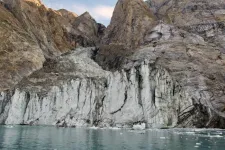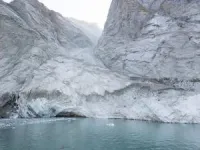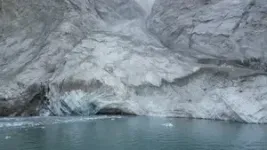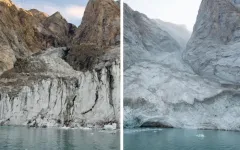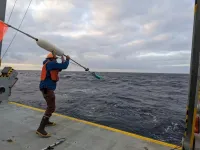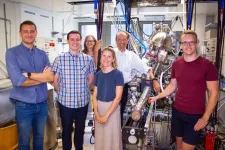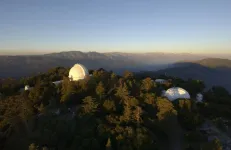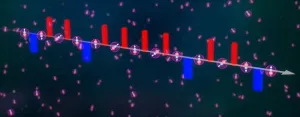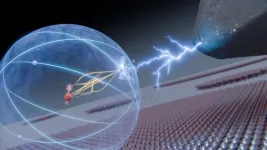(Press-News.org) In September 2023, scientists around the world detected a mysterious seismic signal that lasted for nine straight days. An international team of scientists, including seismologists Alice Gabriel and Carl Ebeling of UC San Diego’s Scripps Institution of Oceanography came together to solve the mystery.
A new study published today in Science provides the stunning solution: In an East Greenland fjord, a mountaintop collapsed into the sea and triggered a mega-tsunami about 200 meters (650 feet) tall. The giant wave rocked back and forth inside the narrow fjord for nine days, generating the seismic waves that reverberated through Earth’s crust, baffling scientists around the world. This rhythmic sloshing is a phenomenon known as a seiche. Fortunately, no people were hurt, but the waves destroyed some $200,000 in infrastructure at an unoccupied research station on Ella Island.
“When we set out on this scientific adventure, everybody was puzzled and no one had the faintest idea what caused this signal,” said Kristian Svennevig, a geologist at the Geological Survey of Denmark and Greenland (GEUS) and the study’s lead author. “All we knew was that it was somehow associated with the landslide. We only managed to solve this enigma through a huge interdisciplinary and international effort.”
Climate change set the stage for the landslide by melting the glacier at the base of the mountain, destabilizing the more than 25 million cubic meters (33 million cubic yards) of rock and ice – enough to fill 10,000 Olympic-sized swimming pools – that ultimately crashed into the sea. As climate change continues to melt Earth’s polar regions it could lead to an increase in large, destructive landslides such as this one.
“Climate change is shifting what is typical on Earth, and it can set unusual events into motion,” said Gabriel, whose work on this study was supported by the European Research Council, Horizon Europe, the National Science Foundation (NSF) and NASA.
When seismic monitoring networks first detected this signal in September 2023, it was puzzling for two main reasons. First, the signal looked nothing like the busy squiggle that earthquakes produce on seismographs. Instead, it oscillated with a 92-second-interval between its peaks, too slow for humans to perceive. Second, the signal stayed strong for days on end, where more common seismic events weaken more rapidly.
The global community of Earth scientists started buzzing with online discussion of what could be causing the strange seismic waves. The discussion turned up reports of a huge landslide in a remote Greenland fjord that occurred on Sept. 16, around the time the seismic signal was first detected.
To figure out if and how these two phenomena might be connected, the team, led by Kristian Svennevig of the Geological Survey of Denmark and Greenland, combined seismic recordings from around the world, field measurements, satellite imagery and computer simulations to reconstruct the extraordinary events.
The team, comprised of 68 scientists from 41 research institutions, analyzed satellite and on-the-ground imagery to document the enormous volume of rock and ice in the landslide that triggered the tsunami. They also analyzed the seismic waves to model the dynamics and trajectory of the rock-ice avalanche as it moved down the glacial gully and into the fjord.
To understand the tsunami and resulting seiche, the researchers used supercomputers to create high-resolution simulations of the events.
“It was a big challenge to do an accurate computer simulation of such a long-lasting, sloshing tsunami,” said Gabriel.
Ultimately, these simulations were able to closely match the real-world tsunami’s height as well as the long-lasting seiche’s slow oscillations.
By integrating these diverse data sources, the researchers determined that the nine-day seismic signal was caused by the massive landslide and resulting seiche within Greenland’s Dickson Fjord.
“It was exciting to be working on such a puzzling problem with an interdisciplinary and international team of scientists,” said Robert Anthony, a geophysicist with the United States Geological Survey’s Earthquake Hazards program and co-author of the study. “Ultimately, it took a plethora of geophysical observations and numerical modeling from researchers across many countries to put the puzzle together and get a complete picture of what had occurred.”
The study’s findings demonstrate the complex, cascading hazards posed by climate change in polar regions. While no people were in the area when the landslide and mega-tsunami occurred, the fjord is close to a route commonly used by cruise ships, highlighting the need to monitor polar regions as climate change accelerates. For example, a landslide in western Greenland’s Karrat Fjord in 2017 triggered a tsunami that flooded the village of Nuugaatsiaq, destroying 11 houses and killing four people.
Gabriel said the results could also inspire researchers to comb back through the seismic record to look for similar events now that scientists know what to look for. Finding more seiches could help more clearly define the conditions that give rise to the phenomenon.
“This shows there is stuff out there that we still don’t understand and haven’t seen before,” said Ebeling, who co-authored the study with support from NSF and helped manage a network of seismic sensors that detected the seiche’s vibrations. “The essence of science is trying to answer a question we don’t know the answer to – that’s why this was so exciting to work on.”
END
Climate change-triggered landslide unleashes a 650-foot mega-tsunami
Wave created a seismic signal that lasted for nine days
2024-09-12
ELSE PRESS RELEASES FROM THIS DATE:
New study reveals food waste bans ineffective in reducing landfill waste, except in Massachusetts
2024-09-12
Of the first five U.S. states to implement food waste bans, only Massachusetts was successful at diverting waste away from landfills and incinerators, according to a new study from the University of California Rady School of Management.
The paper, published today in Science, suggests a need to reevaluate current strategies, citing Massachusetts' approach as a benchmark for effective policy implementation.
Between 2014 and 2024, nine U.S. states made it unlawful for commercial waste generators—such as grocery chains—to dispose of their food waste in landfills, expecting a 10–15% waste reduction.
“We ...
New research reveals how El Nino caused the greatest ever mass extinction
2024-09-12
Mega ocean warming El Niño events were key in driving the largest extinction of life on planet Earth some 252 million years ago, according to new research.
The study, published today in Science and co-led by the University of Bristol and China University of Geosciences (Wuhan), has shed new light on why the effects of rapid climate change in the Permian-Triassic warming were so devastating for all forms of life in the sea and on land.
Scientists have long linked this mass extinction to vast volcanic eruptions in what is now Siberia. The resulting carbon dioxide emissions rapidly accelerated climate warming, resulting in widespread stagnation and the collapse ...
Climate-change-triggered landslide caused Earth to vibrate for nine days
2024-09-12
A landslide in a remote part of Greenland caused a mega-tsunami that sloshed back and forth across a fjord for nine days, generating vibrations throughout Earth, according to a new study involving UCL researchers.
The study, published in the journal Science, concluded that this movement of water was the cause of a mysterious, global seismic signal that lasted for nine days and puzzled seismologists in September 2023.
The initial event, not observed by human eye, was the collapse of a 1.2km-high mountain peak into the remote Dickson Fjord beneath, causing a backsplash of water 200 metres in the air, with a wave up to 110 metres high. This ...
Microbe dietary preferences influence the effectiveness of carbon sequestration in the deep ocean
2024-09-12
Woods Hole, Mass. (September 13, 2024) - The movement of carbon dioxide (CO2) from the surface of the ocean, where it is in active contact with the atmosphere, to the deep ocean, where it can be sequestered away for decades, centuries, or longer, depends on a number of seemingly small processes.
One of these key microscale processes is the dietary preferences of bacteria that feed on organic molecules called lipids, according to a journal article, "Microbial dietary preference and interactions affect the export of lipids to the deep ocean," published in Science.
"In ...
The insulator unraveled
2024-09-12
Aluminum oxide (Al2O3), also known as alumina, corundum, sapphire, or ruby, is one of the best insulators used in a wide range of applications: in electronic components, as a support material for catalysts, or as a chemically resistant ceramic, to name a few. Knowledge of the precise arrangement of the surface atoms is key to understanding how chemical reactions occur on this material, such as those in catalytic processes. Atoms inside the material follow a fixed arrangement, giving rise to the characteristic shapes ...
$3.5M grant to Georgia State will fuel space research across the globe
2024-09-12
ATLANTA — A new three-year, $3.5 million grant from the U.S. National Science Foundation will foster new research at Georgia State’s Center for High Angular Resolution Astronomy (CHARA) Array by astronomers from around the world.
The grant will fund open-access time at the CHARA Array through the NSF National Optical-Infrared Astronomy Research Laboratory (NSF NOIRLab). The program offers astronomers the opportunity to apply for observing time at the CHARA Array to investigate all kinds of objects ...
Polar molecules dance to the tunes of microwaves
2024-09-12
The interactions between quantum spins underlie some of the universe’s most interesting phenomena, such as superconductors and magnets. However, physicists have difficulty engineering controllable systems in the lab that replicate these interactions.
Now, in a recently published Nature paper, JILA and NIST Fellow and University of Colorado Boulder Physics Professor Jun Ye and his team, along with collaborators in Mikhail Lukin’s group at Harvard University, used periodic microwave pulses in a process known as Floquet engineering, to tune interactions between ultracold potassium-rubidium molecules in a system appropriate for studying fundamental magnetic ...
Quantum researchers cause controlled ‘wobble’ in the nucleus of a single atom
2024-09-12
Researchers from Delft University of Technology in The Netherlands have been able to initiate a controlled movement in the very heart of an atom. They caused the atomic nucleus to interact with one of the electrons in the outermost shells of the atom. This electron could be manipulated and read out through the needle of a scanning tunneling microscope. The research, published in Nature Communications today, offers prospects for storing quantum information inside the nucleus, where it is safe from external disturbances.
For weeks on end, the researchers studied a single titanium atom. “A Ti-47 atom, to be precise,” ...
Foods with low Nutri-Scores associated with an increased risk of cardiovascular diseases
2024-09-12
Cardiovascular diseases are the leading cause of mortality in Western Europe, accounting for 1/3 of deaths in 2019. Diet is thought to be responsible for around 30% of such deaths. Nutrition-related prevention policies therefore constitute a major public health challenge for these diseases.
In an article to be published on 11 September 2024 in Lancet Regional Health - Europe, researchers from the Nutritional Epidemiology Research Team (CRESS-EREN), with members from Inserm, Inrae, Cnam, Université Sorbonne Paris Nord and Université Paris ...
Research reveals reality of Ice Age teen puberty
2024-09-12
Landmark new research shows Ice Age teens from 25,000 years ago went through similar puberty stages as modern-day adolescents. In a study published today in the Journal of Human Evolution of the timing of puberty in Pleistocene teens, researchers are addressing a knowledge gap about how early humans grew up.
Found in the bones of 13 ancient humans between 10 and 20 years old is evidence of puberty stages. Co-led by University of Victoria (UVic) paleoanthropologist April Nowell, researchers found specific markers in the bones that allowed them to assess the progress of adolescence.
“By analyzing specific areas of the skeleton, we inferred things like menstruation ...
LAST 30 PRESS RELEASES:
Making lighter work of calculating fluid and heat flow
Normalizing blood sugar can halve heart attack risk
Lowering blood sugar cuts heart attack risk in people with prediabetes
Study links genetic variants to risk of blinding eye disease in premature infants
Non-opioid ‘pain sponge’ therapy halts cartilage degeneration and relieves chronic pain
AI can pick up cultural values by mimicking how kids learn
China’s ecological redlines offer fast track to 30 x 30 global conservation goal
Invisible indoor threats: emerging household contaminants and their growing risks to human health
Adding antibody treatment to chemo boosts outcomes for children with rare cancer
Germline pathogenic variants among women without a history of breast cancer
Tanning beds triple melanoma risk, potentially causing broad DNA damage
Unique bond identified as key to viral infection speed
Indoor tanning makes youthful skin much older on a genetic level
Mouse model sheds new light on the causes and potential solutions to human GI problems linked to muscular dystrophy
The Journal of Nuclear Medicine ahead-of-print tip sheet: December 12, 2025
Smarter tools for peering into the microscopic world
Applications open for funding to conduct research in the Kinsey Institute archives
Global measure underestimates the severity of food insecurity
Child survivors of critical illness are missing out on timely follow up care
Risk-based vs annual breast cancer screening / the WISDOM randomized clinical trial
University of Toronto launches Electric Vehicle Innovation Ontario to accelerate advanced EV technologies and build Canada’s innovation advantage
Early relapse predicts poor outcomes in aggressive blood cancer
American College of Lifestyle Medicine applauds two CMS models aligned with lifestyle medicine practice and reimbursement
Clinical trial finds cannabis use not a barrier to quitting nicotine vaping
Supplemental nutrition assistance program policies and food insecurity
Switching immune cells to “night mode” could limit damage after a heart attack, study suggests
URI-based Global RIghts Project report spotlights continued troubling trends in worldwide inhumane treatment
Neutrophils are less aggressive at night, explaining why nighttime heart attacks cause less damage than daytime events
Menopausal hormone therapy may not pose breast cancer risk for women with BRCA mutations
Mobile health tool may improve quality of life for adolescent and young adult breast cancer survivors
[Press-News.org] Climate change-triggered landslide unleashes a 650-foot mega-tsunamiWave created a seismic signal that lasted for nine days
